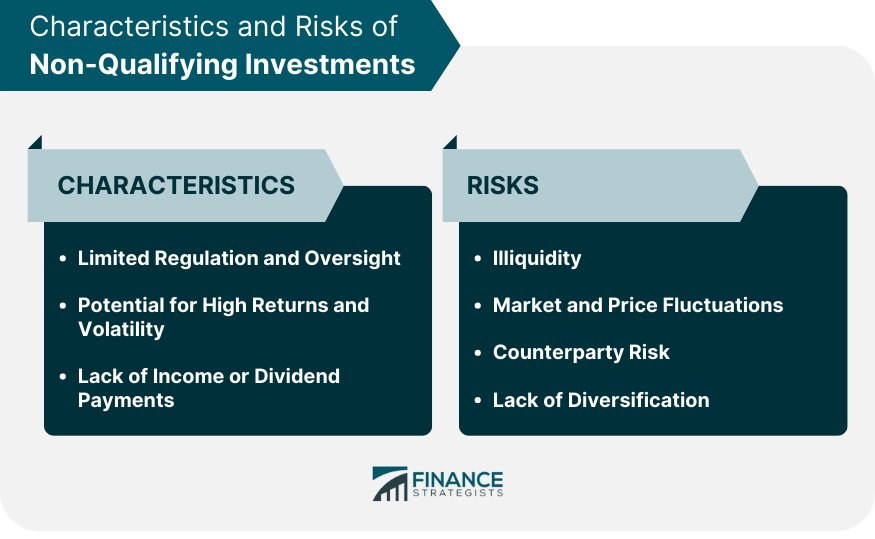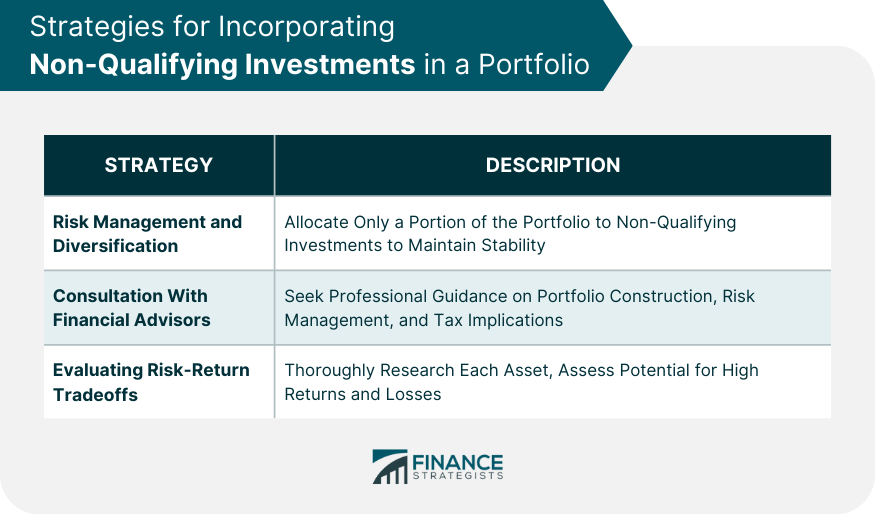A non-qualifying investment refers to assets that do not meet the criteria for inclusion in certain tax-advantaged accounts, such as individual retirement accounts (IRAs) or tax-free savings accounts (TFSAs). These types of investments typically involve alternative assets, such as real estate, collectibles, and cryptocurrencies, which may not be subject to the same regulatory oversight and reporting requirements as traditional investments like stocks and bonds. Non-qualifying investments can offer investors the opportunity to diversify their portfolios and potentially achieve higher returns by investing in alternative assets. However, due to their unique characteristics and associated risks, these investments may not be suitable for all investors, and their inclusion in a portfolio should be carefully considered based on individual risk tolerance and investment objectives. Real estate is a common type of non-qualifying investment, as it typically does not meet the criteria for inclusion in tax-advantaged accounts. This can include direct investments in properties, as well as indirect investments through real estate investment trusts (REITs) or limited partnerships. Collectibles, such as art, antiques, stamps, and coins, are another type of non-qualifying investment. These assets often have unique characteristics and value drivers that are not directly correlated with traditional financial markets, making them an appealing option for diversification purposes. Investments in precious metals, such as gold and silver, or gemstones like diamonds and rubies, are also considered non-qualifying investments. These assets are often used as a hedge against inflation or market volatility and can provide diversification benefits to a portfolio. Cryptocurrencies, like Bitcoin and Ethereum, are a relatively new type of non-qualifying investment. These digital assets have gained popularity in recent years due to their potential for high returns and decentralized nature but are subject to significant price fluctuations and regulatory uncertainty. One of the defining characteristics of non-qualifying investments is their limited regulation and oversight compared to traditional investments. This lack of regulation can result in increased risk and uncertainty for investors, as well as potential difficulties in obtaining accurate information and valuations for these assets. Non-qualifying investments often have the potential for higher returns than traditional investments, as they may be less correlated with broader market trends and offer unique value drivers. However, this potential for high returns is often accompanied by increased volatility, making these investments more suitable for investors with a higher risk tolerance. Many non-qualifying investments, such as collectibles or cryptocurrencies, do not generate regular income or dividend payments, which can be a disadvantage for investors seeking a steady stream of income from their investments. Instead, the value of these assets is typically derived from their appreciation over time, which may be subject to significant fluctuations and uncertainty. Non-qualifying investments can often be illiquid, meaning that they may be difficult to buy or sell quickly and at a desirable price. This lack of liquidity can pose challenges for investors who need to access their funds or adjust their portfolios, potentially resulting in financial losses or missed investment opportunities. Non-qualifying investments are often subject to significant market and price fluctuations, as their value may be driven by unique factors that are not directly correlated with broader financial markets. This increased volatility can lead to substantial fluctuations in the value of these assets, potentially resulting in financial losses for investors who are not prepared to manage these risks. Counterparty risk is another potential concern for investors in non-qualifying investments, as transactions involving these assets may not be subject to the same regulatory oversight and protections as traditional investments. This can result in increased risk of fraud, default, or other adverse outcomes for investors who engage in transactions with unreliable counterparties. Investing heavily in non-qualifying investments can also lead to a lack of diversification in a portfolio, as these assets may not provide the same risk-reduction benefits as more traditional investments. A well-diversified portfolio typically includes a mix of asset classes, such as stocks, bonds, and cash, which can help to mitigate the risks associated with individual investments and market fluctuations. Capital gains tax implications may apply to non-qualifying investments, as these assets are typically not eligible for inclusion in tax-advantaged accounts. Depending on the investor's jurisdiction and the specific asset in question, the sale of non-qualifying investments may be subject to capital gains tax, which can reduce the overall return on these assets. Investors in non-qualifying investments may also face additional reporting requirements, as these assets may not be subject to the same regulatory reporting standards as traditional investments. This can include the need to report the acquisition, sale, or valuation of these assets on tax returns, which can be complex and time-consuming for investors who are not familiar with the relevant regulations. In some cases, losses incurred on non-qualifying investments may not be deductible for tax purposes, which can further reduce the appeal of these assets for certain investors. This limitation can make it more difficult for investors to offset gains from other investments with losses from non-qualifying investments, potentially resulting in higher tax liabilities. When incorporating non-qualifying investments into a portfolio, it's crucial to practice effective risk management and diversification strategies. This may involve allocating a smaller portion of the portfolio to these alternative assets, while maintaining a larger allocation to more traditional investments that offer greater stability and diversification benefits. Given the unique risks and characteristics of non-qualifying investments, consulting with a financial advisor can be an essential step in determining whether these assets are suitable for an individual's investment objectives and risk tolerance. Financial advisors can provide valuable guidance on portfolio construction, risk management, and tax implications associated with non-qualifying investments. Investors should carefully evaluate the risk-return tradeoffs associated with non-qualifying investments before incorporating them into their portfolios. This may involve researching the specific asset in question, assessing the potential for both high returns and significant losses, and determining whether the potential benefits of these investments outweigh the associated risks. Non-qualifying investments are assets that do not meet the criteria for inclusion in certain tax-advantaged accounts, often involving alternative assets like real estate, collectibles, and cryptocurrencies. These investments are characterized by limited regulation and oversight, potential for high returns and volatility, and a lack of income or dividend payments. Incorporating non-qualifying investments into a portfolio should involve careful risk management and diversification, consultation with financial advisors, and a thorough evaluation of risk-return tradeoffs. By taking these factors into consideration, investors can make informed decisions about whether non-qualifying investments are appropriateWhat Is a Non-Qualifying Investment?
Types of Non-Qualifying Investments
Real Estate
Collectibles
Precious Metals and Gemstones
Cryptocurrencies
Characteristics of Non-Qualifying Investments
Limited Regulation and Oversight
Potential for High Returns and Volatility
Lack of Income or Dividend Payments
Risks Associated With Non-Qualifying Investments
Illiquidity
Market and Price Fluctuations
Counterparty Risk
Lack of Diversification

Tax Implications of Non-Qualifying Investments
Capital Gains Tax
Reporting Requirements
Non-Deductible Losses
Strategies for Incorporating Non-Qualifying Investments in a Portfolio
Risk Management and Diversification
Consultation With Financial Advisors
Evaluating Risk-Return Tradeoffs

Conclusion
Non-Qualifying Investment FAQs
Non-qualifying investments refer to assets that don't meet certain eligibility criteria for tax advantages or inclusion in specific accounts.
Non-qualifying investments typically lack tax advantages, have limited liquidity, and carry higher risk compared to qualified investments.
Examples include speculative investments like cryptocurrencies and derivatives, restricted investments such as non-publicly traded securities, and prohibited investments like illegal activities or fraudulent schemes.
Investing in non-qualifying investments may result in limited tax benefits, potential tax liabilities, higher volatility, and a need for professional advice and due diligence.
Diversification, maintaining a balanced investment portfolio, and seeking guidance from financial advisors are key strategies to mitigate risks associated with non-qualifying investments.
True Tamplin is a published author, public speaker, CEO of UpDigital, and founder of Finance Strategists.
True is a Certified Educator in Personal Finance (CEPF®), author of The Handy Financial Ratios Guide, a member of the Society for Advancing Business Editing and Writing, contributes to his financial education site, Finance Strategists, and has spoken to various financial communities such as the CFA Institute, as well as university students like his Alma mater, Biola University, where he received a bachelor of science in business and data analytics.
To learn more about True, visit his personal website or view his author profiles on Amazon, Nasdaq and Forbes.













